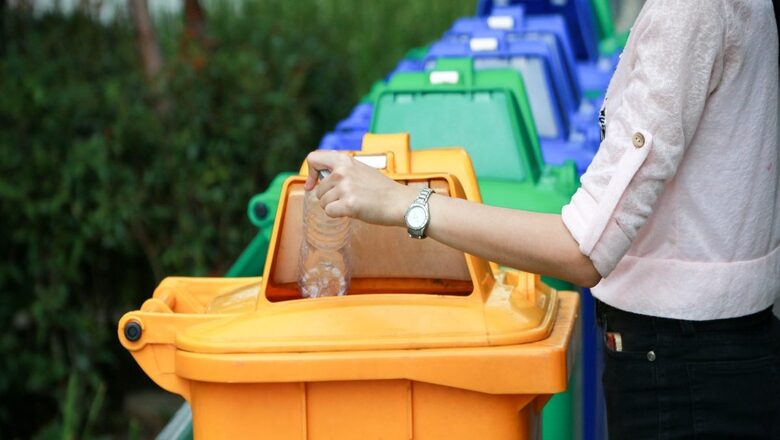
views
With the advent of plastic into human habitats, a noticeable compromise has sneaked into environmental concerns. The lacuna in waste management from authorities had converted vacant public and private spaces into easy targets for waste disposal. Once, our rivers used to be the potable source of water for many, but today, it is not the case. We are more troubled by man-made disasters than natural ones and have yet to master the use of our resources effectively and contain our own dirt. Indeed, with a growing population, we are a burden to nature though we don’t agree with the truth in ease.
The awareness of our obligation to take care of the environment is not limited, the future generations are completely secreted in the consequences of our actions. Environmental, social, and governance (ESG) and sustainability aspects are a point of discussion in every larger development, internationally and nationally. Every state has its unique nature, but the people’s right to have basic infrastructure facilities must be part of a fundamental one.
Solid Waste Treatment
As per the Central Pollution Control Board (CPCB) annual report 2020-2021, India generated 160038.9 TDP, collected 152749.6 TDP (95 per cent), and treated 79956 TDP (50 per cent). This means 45 per cent of the collected waste is not treated. Bihar is collecting 95 per cent of the generated waste but has not provided the data available for treatment (in 2015, it was zero percentage), which means either a shortfall of adequate facilities or complete depending on the dumping yard.
As per CPCB, West Bengal has the capability to treat 5 per cent of the waste generated. Andhra Pradesh has 16 per cent, and Assam, Meghalaya, and Pondicherry have less than 10 per cent of treatment facilities. Kerala is collecting only 27 per cent of waste generated balance, considered to be treated at the source. Waste management and treatment was a neglected area for a long period, however, substantial progress has been achieved in waste treatment plant inclusions in the last ten years, but a lot more has to be done. A focused approach is inevitable for urban areas.
Our governing system should support wielding preventive action than more corrective action. For Example, Kochi witnessed one of the major crises when the Brahmapuram waste treatment plant fire broke out in March 2023, and the media gave due importance to the incident, which flared into national importance. There was a huge uproar from every corner of the state. The toxic smoke and health issues led the schools and nearby institutions to shut down for a few days and the neighbouring people had to shift over to safe places for a short period.
The total area of the Brahmapuram treatment plant is 110 acres, touching the rivers Kadambrayar and Chithrapuzha. Indeed, the land was used as a dumping yard than a treatment facility. The heap of dumped waste was close to twenty-five feet high at the time of the fire breakout.
Kochi alone produces an estimated 250-300 tons of waste per day, and 90 per cent is collected for recycling and treatment. The shortfall of adequate facilities to recycle and treat daily generated waste is well known to the authorities, hence the dumping became a matter of convenience. The ineffectiveness of the treatment plant was not noticed by the public till the fire broke out. The water contamination is extreme during the monsoon season.
Opposition leader, VD Satheeshan, had raised the matter in the assembly and debated for several days. The authorities realised the seriousness and acted, but it took twelve days to contain the fire with considerable commercial impact. Some sections of people still believe the Brahmapuram fire was an intentional act for a respective reason than an accident. However, an enquiry was conducted and it was concluded as an accident.
Subsequently, the authorities took some actions and regulations to treat the waste at its source. They asked the residents to process the waste from the source, but the majority of people live in a congested neighbourhood. Then the authorities appointed various agencies to collect the waste. BPCL and Cochin Corporation has agreed to build a new treatment plant in Kochi. Further details are yet to be announced.
The residents, institutions, and schools nearby the Brahamapuram plant are destined to inhale a foul smell occasionally. They wait for an effective odour control mechanism in the treatment plant or an advanced treatment machinery system that will help contain the smell.
There are challenges in acquiring land in highly dense areas like Kerala. It may be more suitable to explore a combination of decentralised and centralised treatment plants for panchayat, municipalities and corporations. The question is whether the collected 27 per cent of waste in Kerala is treated within due standards and do we have sufficient facilities to recycle and treat such collected waste. Do we have a mechanism to monitor the balance of waste treated at the source, as this scenario is applicable to many cities in India? However, it is important to note that Indore, Chandigarh and Alappuzha are doing a good job in solid waste management.
Unknowingly, we are banking on single-use products across the consumer base, whereas the effective implementation of multi-use products shall help reduce waste generation.
Wastewater Treatment
As per the Ministry of Jal Shakti press release, the total sewage generation in India is 76368 MLD and STPs are installed to treat 44 per cent of waste generated. According to the Ministry of Housing and Urban Affairs, Bangalore’s wastewater connected to the common network as per the 2021 update is 70 per cent, Mumbai 85 per cent, Hyderabad 40 per cent, Delhi 80 per cent, Chennai 90 per cent, Indore 100 per cent and Chandigarh 100 per cent.
The lacuna in sufficient and effective sewage infrastructure networks is an invisible danger for a congested city that lies below the mean sea level. In Kochi, less than 5 per cent of the wastewater network is connected to a common sewage system and the balance fully depends on the individual septic tank facilities which authorities have no major control over. The groundwater table is comparatively high than in any other city in India.
Kerala Municipal Building Rule (KMBR) regulates a minimum 7.5 M radial distance between the septic tank cockpit and the drinking water source. The majority of independent houses are within three to five cents of land (1305-2175 sq ft), accommodating the open well and a septic tank in a congested neighbourhood. Practically an impossible task to manage the well and the tank within the regulations of the congested neighbourhood. The presence of coliform bacteria in our groundwater is identified in various locations so the challenges are not limited. The septic tank sewage collection and disposal is another critical area to be looked at more pragmatically. Easy targets are the culverts, open drains and the river or forest land, though there is set regulation on disposal. Many such cases are registered on illegal disposals.
Chandigarh has upgraded the treatment plant and has reported that they are self-sufficient to deal with the wastewater generated for the next 15 years. Indore is another example to follow. Such best examples can be followed within the country to improve our infra facilities. The cities of India need a more focused approach to wastewater management.
In Mumbai, Prime Minister Narendra Modi inaugurated a wastewater treatment plant worth Rs 26000 crore to manage 2464 MLD (million little per day) a few months back.
Kerala’s chief minister visited the Netherlands in the month of May 2023, and such visits are to be welcomed. We must encourage such visits than blind criticism, provided such visits help to create value addition for the state development process and address the challenges we face in similar geographic situations. The Netherlands approaches waste management in an order of preference to avoid waste as much as possible, recover usable and valuable raw materials and generate energy by incinerating the residual. Many countries are progressing well in sustainable waste management facilities and consider it an energy-generating opportunity.
In my opinion, the voters can do much more to resolve the issues with a collective approach by demanding the betterment of basic facilities. Demand election contestants to include an illustrative map of basic infra facilities like waste management, wastewater treatment, and drinking water facilities in their manifesto and see who is capable to deliver, irrespective of political affiliations. When the vision and objectives are set, then the support and fund will flow.
Kerala needs a resurrection and only the voters can make this work. The demand for permanent and practical solutions to basic facilities must be raised by every citizen to face the challenges of the future.
Raveendranath is the author of the book, ‘Sunshine Over Backwaters’. His Twitter @CRaviram2022. Views expressed in the above piece are personal and solely that of the author. They do not necessarily reflect News18’s views.














Comments
0 comment